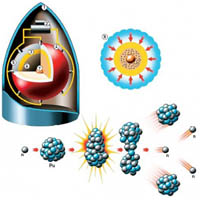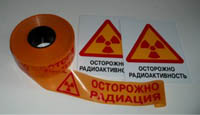Acute radiation disease arises as a result of the effects of ionizing radiation on the biological structures of the body and is an injury of all organs and systems. Depending on the dose of irradiation, 4 degrees of the severity of the lesion are isolated, the greater the dose of radiation exposure, the stronger the irradiation of the body.
Content
The concept of acute radiation disease, diagnosis
 Acute radiation disease is a simultaneous injury of all organs and organism systems, but first of all - acute damage to the hereditary structures of dividing cells, preferably blood-forming bone marrow cells, lymphatic system, the epithelium of the gastrointestinal tract and skin, liver cells, lungs and other organs. The affecting effect has ionizing radiation.
Acute radiation disease is a simultaneous injury of all organs and organism systems, but first of all - acute damage to the hereditary structures of dividing cells, preferably blood-forming bone marrow cells, lymphatic system, the epithelium of the gastrointestinal tract and skin, liver cells, lungs and other organs. The affecting effect has ionizing radiation.
Being an injury, radiation damage to biological structures has a strictly quantitative character, t.E. Small impacts may be invisible, large can cause disastrous lesions. A significant role is played by the dose rate of radiation exposure: the same amount of radiation energy absorbed by the cell causes the greater damage to biological structures, the shorter the term of irradiation. Large doses of exposure, stretched in time, cause significantly smaller damage than the same doses absorbed in a short time.
The main characteristics of radiation damage are the biological and clinical effect, which is determined by the dose of irradiation («Dose - Effect»), on the one hand, and on the other, this effect is due to the dose capacity («Dose power - effect»).
Immediately after the irradiation of a person, the symptoms of the lesion turns out to be scarce, sometimes there are no manifestations. That is why the knowledge of human irradiation dose plays a decisive role in the diagnosis and early prediction of the course of acute radiation disease, in determining therapeutic tactics to the development of the main symptoms of the disease.
Severity of acute radiation disease
How many degrees of radiation sickness exist: in accordance with the dose of radiation exposure, the ray radiation disease is made to divide 4 degrees of gravity:
- Light (radiation dose in the range of 1-2 grade)
- Middle (2-4 Gray)
- Heavy (4-6 Gray)
- extremely heavy (6 Gray)
Degree of manifestation of radiation disease
When irradiated at a dose of less than 1 Gray, they talk about acute radial injury without signs of the disease, although small changes in blood in the form of a transient reduction in the number of leukocytes and platelets after about a month and a half after irradiation. In itself, the division of patients in the degrees of gravity is very conditional and pursues specific objectives of sorting patients and in relation to their specific organizational - therapeutic measures.
The system for determining the dose loads with biological (clinical and laboratory) indicators in the affected by the influence of ionizing radiation received the name of biological dosimetry. In this case, it is not about true dosimetry, not about calculating the amount of radiation energy absorbed by tissues, but on the correspondence of certain biological changes in the approximate dose of short-term, simultaneous overall irradiation. With this method, the severity of the disease is determined.
When irradiated without the development of signs of the disease (dose of radiation up to 1 Gray) or acute radiation disease, easy severity (1-2 Gray) patients in special treatment do not need, they only need an outpatient surveillance. Patients may be left (with the exclusion of additional irradiation) on site or enshrined behind a local medical institution, closest to the accident area (accommodation).
Under the acute radiation disease of the average severity (1-2 Gray), the victim need treatment in the hospital, and previously the beginning of a specialized treatment guarantees the survival and development of minimal consequences.
Acute radiation disease of severe severity (4-6 Gray) is characterized by the likely survival of patients with a timely manner.
With acute radiation disease, extremely severe (more than 6 grams) survival in treatment is possible in isolated cases. Tactics in relation to this group of patients differs in mass lesions and small incidents.
Separation of acute radiation disease according to severity, based on dosage loads, and not on the nature and severity of the painful manifestations themselves, allow, first of all, to get rid of the hospitalization of persons with a dose of less than 1 Gray. Only persons with a death lesion when the dose of irradiation exceeds 4 Gray, immediate hospitalization is needed to a specialized hematological hospital, since irradiation posts in the blood system in the coming days or weeks, a deep decrease in platelets, developing a bowel (enteropathy) develops , Stomatitis, radiation lesion of the skin and internal organs. The damage of blood is developing at acute radiation disease of the average severity, so such victims also need hospitalization, but with mass defeat in exceptional cases, it can be postponed for 2 weeks.









